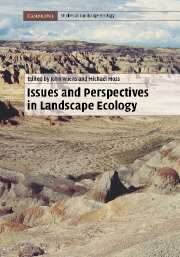Book contents
- Frontmatter
- Contents
- List of contributors
- Preface
- PART I Introductory perspectives
- PART II Theory, experiments, and models in landscape ecology
- 3 Theory in landscape ecology
- 4 Hierarchy theory and the landscape … level? or, Words do matter
- 5 Equilibrium versus non-equilibrium landscapes
- 6 Disturbances and landscapes: the little things count
- 7 Scale and an organism-centric focus for studying interspecific interactions in landscapes
- 8 The role of experiments in landscape ecology
- 9 Spatial modeling in landscape ecology
- 10 The promise of landscape modeling: successes, failures, and evolution
- PART III Landscape patterns
- PART IV Landscape dynamics on multiple scales
- PART V Applications of landscape ecology
- PART VI Cultural perspectives and landscape planning
- PART VII Retrospect and prospect
- Index
- Plate section
- References
3 - Theory in landscape ecology
from PART II - Theory, experiments, and models in landscape ecology
Published online by Cambridge University Press: 20 November 2009
- Frontmatter
- Contents
- List of contributors
- Preface
- PART I Introductory perspectives
- PART II Theory, experiments, and models in landscape ecology
- 3 Theory in landscape ecology
- 4 Hierarchy theory and the landscape … level? or, Words do matter
- 5 Equilibrium versus non-equilibrium landscapes
- 6 Disturbances and landscapes: the little things count
- 7 Scale and an organism-centric focus for studying interspecific interactions in landscapes
- 8 The role of experiments in landscape ecology
- 9 Spatial modeling in landscape ecology
- 10 The promise of landscape modeling: successes, failures, and evolution
- PART III Landscape patterns
- PART IV Landscape dynamics on multiple scales
- PART V Applications of landscape ecology
- PART VI Cultural perspectives and landscape planning
- PART VII Retrospect and prospect
- Index
- Plate section
- References
Summary
Over the past decade, landscape ecology has seen a period of remarkable progress. Remote imagery has provided new access to spatial data. Geographic information systems (GIS) have facilitated the handling, analysis, and display of spatial data. New theory has provided the means to quantify pattern (O'Neill et al., 1988a), test hypotheses against random expectations (Gardner et al., 1987), and come to grips with complexity (Milne, 1991) and scale (Turner et al., 1993). The stage seems set for breakthroughs in the new millennium. Nowhere in the field of ecology is there greater promise, nowhere are there more exciting challenges.
This paper has a simple outline. The following sections review four areas of theory that have been applied to spatial effects in ecology. Each theory is then examined to identify the key advances that will be needed to apply the theory to our understanding of landscape dynamics. The intent is to propose an explicit list of major challenges for landscape theory.
Hierarchy theory and landscape scale
The concept of spatial hierarchy has already proven its value. Hierarchy theory (Allen and Starr, 1982; O'Neill et al., 1986) states that ecosystem processes are organized into discrete scales of interaction. The scaled temporal dynamics, in turn, impose discrete spatial scales on the landscape. O'Neill et al. (1991) examined vegetation transects from four ecosystems and established that multiple scales of pattern actually existed in the field.
- Type
- Chapter
- Information
- Issues and Perspectives in Landscape Ecology , pp. 23 - 28Publisher: Cambridge University PressPrint publication year: 2005
References
- 2
- Cited by



